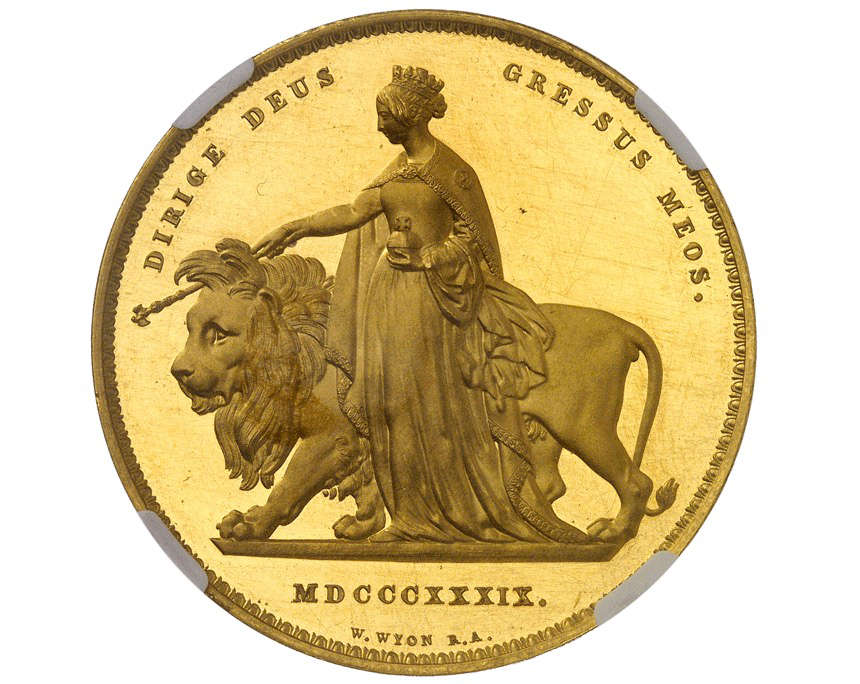Top Prices for British and Chinese Rarities
Künker, Osnabrück
Auctions 387-388
Coins
20-22 June 2023
D-Osnabrück
From 20 to 22 June 2023, the two public auctions of Künker’s Summer Auction Sales took place. Almost 1,800 lots were sold at a total hammer price of 7.1m euros, which is an increase of 34% compared to the total estimate of 5.3m euros.
As always, many special collections were on offer, including, for example, 21 rarities from the Gunnar Ekström Collection. Rarity, quality and – of course – provenance led to outstanding results. The small series was sold at three times its estimate. Although none of the pieces made it into our top ten ranking, we do not want to miss out on presenting at least the most expensive coin of this small ensemble.
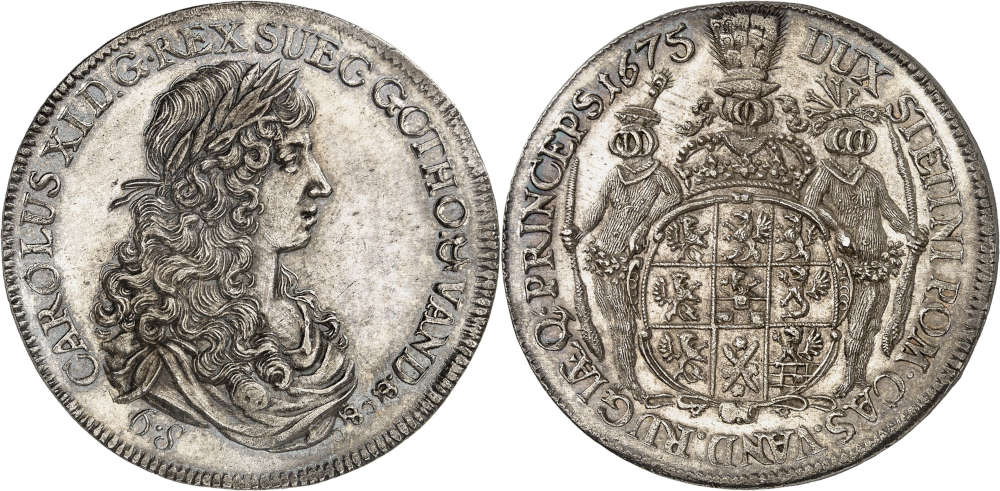
No. 15: Sweden. Charles XI, 1660-1697. 1675 reichstaler, Stettin. Extremely rare. From the Carl Friedrich Pogge Collection, Hamburger auction 36 (1903), lot No. 1186, Lars Emil Bruun, Israel Berghman, Virgil Brand and Gunnar Ekström. Extremely fine to FDC. Estimate: 15,000 euros. Hammer price: 50,000 euros.
The extremely rare reichstaler by Charles XI can only be described as a showpiece, and its hammer price of 50,000 euros made it the most expensive coin in the series of Swedish issues owned by Gunnar Ekström. It was not only of magnificent quality, the coin’s provenance was just as impressive. Some of the most important collectors in history were among its former owners, including the German merchant Carl Friedrich Pogge, the Danish butter wholesaler Lars Emil Bruun and the Chicago brewer Virgil Brand.
And this brings us to the top ten results of auction 387 and 388. Whenever two pieces realized the same hammer price, we ranked the coin higher that experienced a more significant increase in value compared to its estimate.
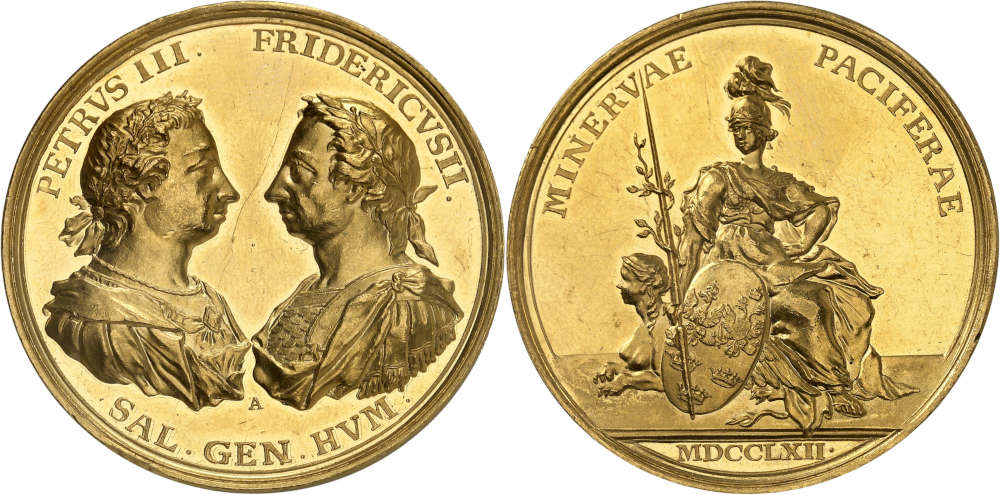
No. 182: Russia. Peter III, 1762. 1762 gold medal commemorating the Treaty of Hamburg between Prussia, Russia and Sweden. Probably the only specimen in private possession. Extremely fine to FDC. Estimate: 100,000 euros. Hammer price: 85,000 euros.
10th Place
The hammer fell at 85,000 euros for a truly historic piece, namely the perfectly preserved gold medal that commemorates the 1762 Treaty of Hamburg concluded by Prussia, Russia and Sweden. This treaty became the watershed for the fate of Prussia and Russia. After all, it enabled Frederick the Great to avoid defeat in the Seven Years’ War; however, Tsar Peter III’s uncompromising desire for peace made him so unpopular with the Russian military that his wife was able to overthrow him.
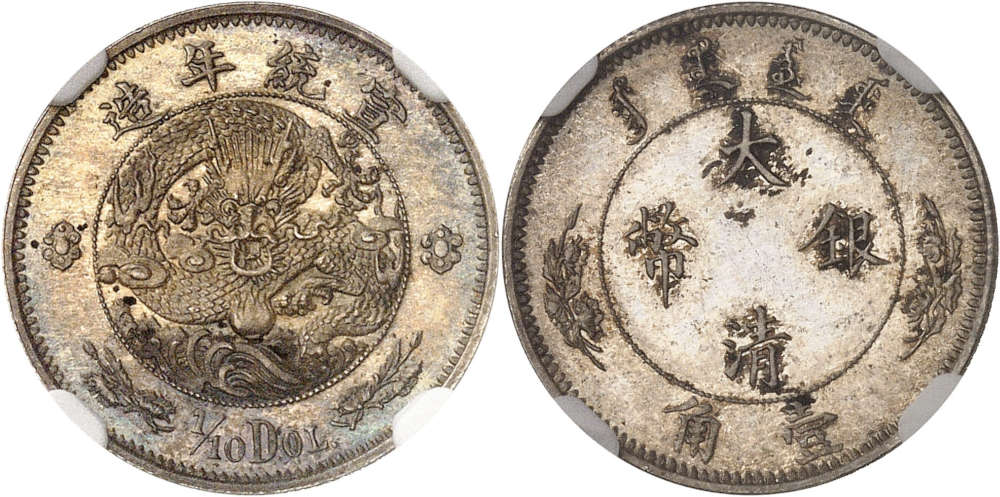
No. 755: China. Xuantong, 1908-1911. 10 cents (1/10 dollar) n.d. (1910), Tientsin. Pattern with reeded edge. NGC PF 64. Very rare. Proof. Estimate: 25,000 euros. Hammer price: 90,000 euros.
9th Place
Chinese coins often fetch surprising results – as did this pattern for a 10-cent piece created in 1910 in Tientsin. A collector was prepared to pay 90,000 euros for this pattern, which is why it realized more than three and a half times its estimate of 25,000 euros.
The piece’s rarity is not the only reason for this high result, its historical importance also played a role. After all, since the 19th century, Tientsin had been the harbor that supplied the capital of Beijing with foreign goods. Many European powers had offices there, which led to conflicts with the local population due to the imperialistic attitude of many Europeans. Therefore, Tientsin became the center of the Boxer Rebellion. After the uprising was suppressed, the city was placed under international administration from 1900 until 1909. The pattern for the Chinese 10-cent piece is therefore a rare testament to China regaining control of Tientsin.
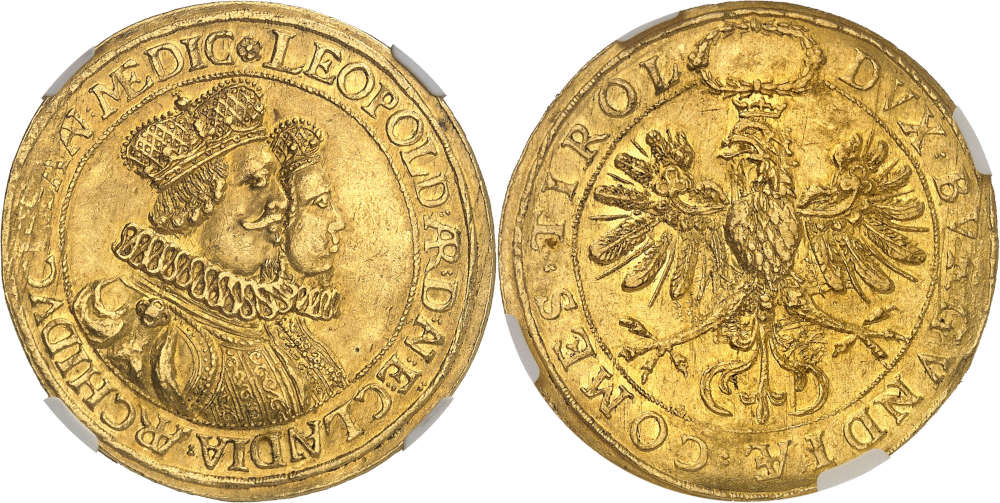
No. 294: Holy Roman Empire. Tyrol. Archduke Leopold V, 1619-1632. 8 ducats n.d. (1626), Hall, commemorating the wedding to Claudia de’ Medici. From the Rudolf Scherer Collection (1912). NGC AU55 (Top Pop). Extremely rare. About extremely fine. Estimate: 100,000 euros. Hammer price: 105,000 euros.
8th Place
105,000 euros was the winning bid of an eightfold ducat by Archduke Leopold V of Tyrol. The latter was the brother of Emperor Ferdinand II and had been governor of Tyrol and Outer Austria since 1619, before advancing to the position of the territory’s rather independent sovereign in 1623. “His” mint was Hall in Tyrol, where this piece was created with the dies that had originally been designed for the wedding half taler. Therefore, the obverse does not only show the portrait of Leopold V but also that of his wife Claudia de’ Medici.
The gold version of this coin is highly rare, and there seems to be a good reason for this: an archival source suggests that Leopold had these coins minted to give them as a present to the Salzburg Archbishop Paris Graf Lodron. The latter might have melted down a major part of these issues when he had the multiple ducats for the consecration of his cathedral minted in 1628.
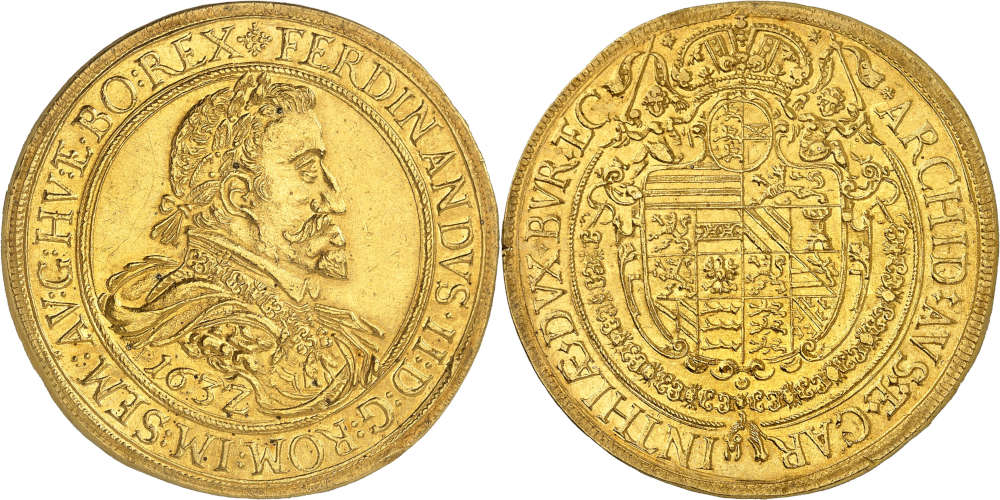
No. 293: Holy Roman Empire. Ferdinand II, 1592-1618-1637. 10 ducats 1632, St. Veit. From the Kroisos Collection, Stack’s auction (2010), No. 483. Extremely rare. Extremely fine. Estimate: 125,000 euros. Hammer price: 110,000 euros.
7th Place
Only a few years after this 8-fold ducat was minted, in 1632 to be precise, the 10-fold ducat with the portrait of Ferdinand II was created, which was sold at 110,000 euros, making it the seventh most expensive coin in our ranking. It was minted in St. Veit / Carinthia.
The local mint was reclaimed by the imperial court at the beginning of the Thirty Years’ War in return for the original sum for which the minting privilege had been pledged to the Carinthian estates. This was a highly symbolic act because many members of the Carinthian estates supported the Reformation while the Counter-Reformation had established itself in St. Veit. This deepened the divide between both cities, which wanted to become the capital of Carinthia. By resuming the production of coins in St. Veit, the Habsburgs supported the ambitions of this city. In the long term, St. Veit developed into the princely capital of Carinthia, while the Carinthian estates resided in Klagenfurt.
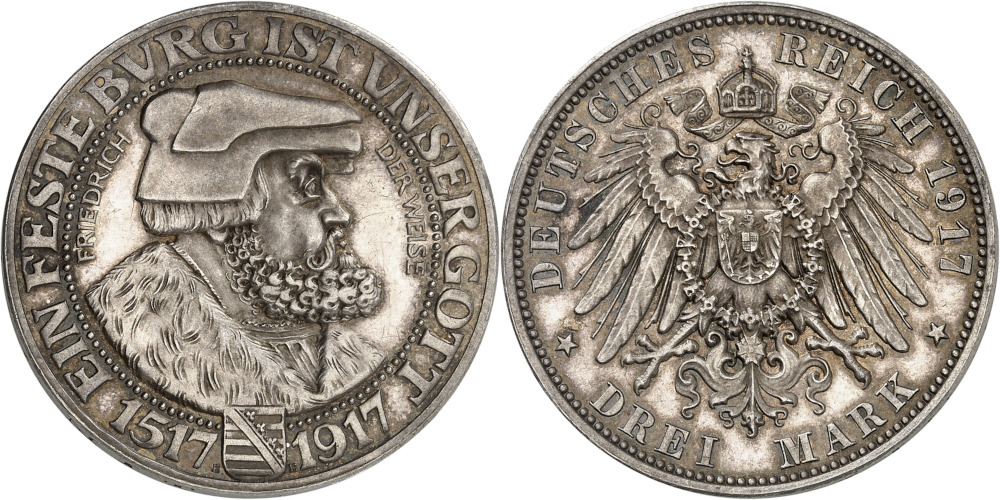
No. 1798: German Empire. Saxony. 3 marks 1917. Frederick the Wise. The rarest silver coin of the German Empire. Proof. Estimate: 100,000 euros. Hammer price: 110,000 euros.
6th Place
The same result of 110,000 euros against an estimate of 100,000 euros was realized by the rarest silver coin of the German Empire, the Saxon 3-mark piece of 1917 featuring the portrait of Frederick the Wise. His story has been recounted many times: Actually, Luther was supposed to be the motif of this commemorative coin, celebrating the anniversary of the Reformation. But the design was rejected on the grounds that the coinage regulation stipulated that only members of the ruling house could be depicted on a coin’s obverse. However, it is quite likely that another reason was behind the rejection: in the midst of the First World War, no one wanted to offend the Catholic states of the German Empire by depicting Luther. Frederick the Wise – a devout Catholic, collector of relics and supporter of Luther – was a perfect compromise.
As few as 100 pieces were minted of the so-called “Frederick the Wise” issue – there was obviously a considerably shortage of silver during the First World War, which is also why a large part of the coins were melted down again.
“Frederick the Wise” is considered the “crowning glory” of any collection of coins from the German Empire. Not only because the coin is so rare but also because of the magnificent coin design, which was inspired by a portrait of the ruler from the Renaissance period.
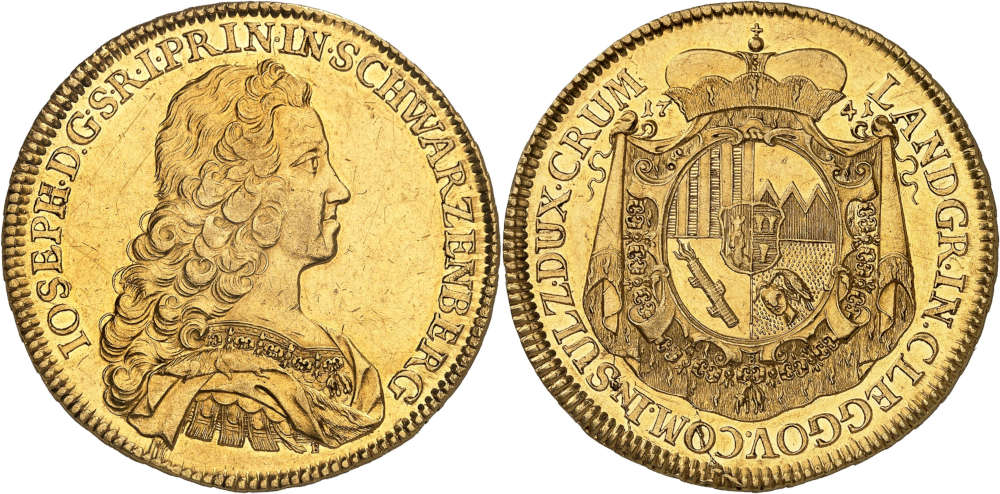
No. 484: Schwarzenberg. Joseph Adam, 1732-1782. 10 ducats 1741, Vienna. Extremely rare. Extremely fine. Estimate: 125,000 euros. Hammer price: 115,000 euros.
5th Place
Let us move on to the 5th place: a 10-fold ducat by Joseph Adam of Schwarzenberg from 1741, which was sold for 115,000 euros. This prince was one of Maria Theresa’s most important officials. He held the office of chamberlain, of the first Grand Master of the Court and later of a minister of state and conference, while he also was Reichserbhofrichter in Rottweil. In return for his loyal service, the imperial court elevated him to the rank of an imperial prince and Bohemian prince. This included the privilege that all legitimate descendants of his, whether female or male, had the right to bear the title of “Fürst” or “Fürstin”. In 1741, the year in which this 10-fold ducat was minted, Joseph I of Schwarzenberg married Maria Theresa of Liechtenstein on 22 August, the daughter of Joseph John Adam of Liechtenstein. It is quite likely that the 10-fold ducat, which changed hands at the Künker sale, was minted in this context.
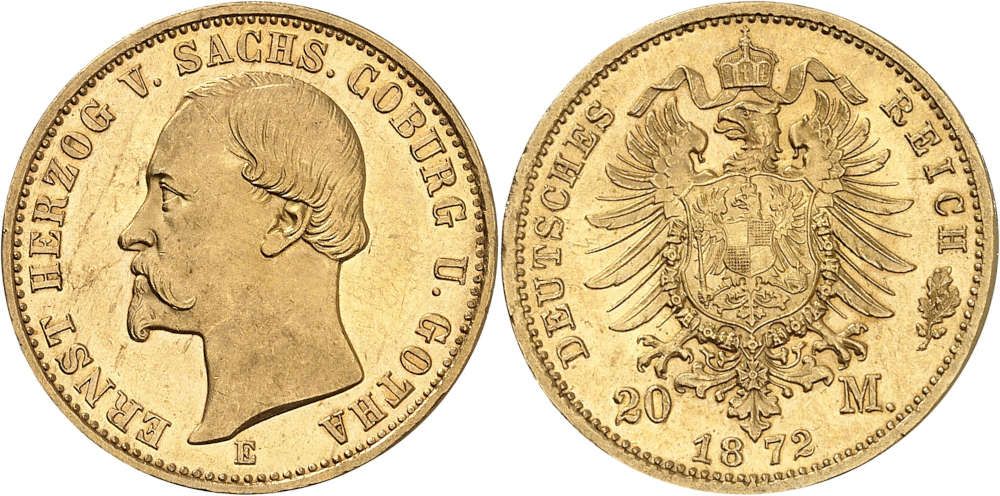
No. 1927: German Empire. Saxe-Coburg and Gotha. 20 marks 1872. Very rare, especially in this quality. Extremely fine to FDC. Estimate: 100,000 euros. Hammer price: 130,000 euros.
3rd Place
This brings us to the first three places in our top ten list. There is no 4th place because two coins climbed from an estimate of 100,000 euros to a hammer price of 130,000 euros. Thus, there are two coins in third place.
For one there is the rarest gold coin of the German Empire, a 20-mark piece by Ernest II of Saxe-Coburg and Gotha, minted in 1872. It is really remarkable that the bids submitted for this coin exceeded those of the rarest silver coin of the Empire even though “Frederick the Wise” is considered much more attractive. We can only speculate whether the outstanding quality of this 20-mark piece was the reason for this or whether its result reflects the international trend towards gold coins. After all, there are only three pieces in our top ten list that are not gold issues.
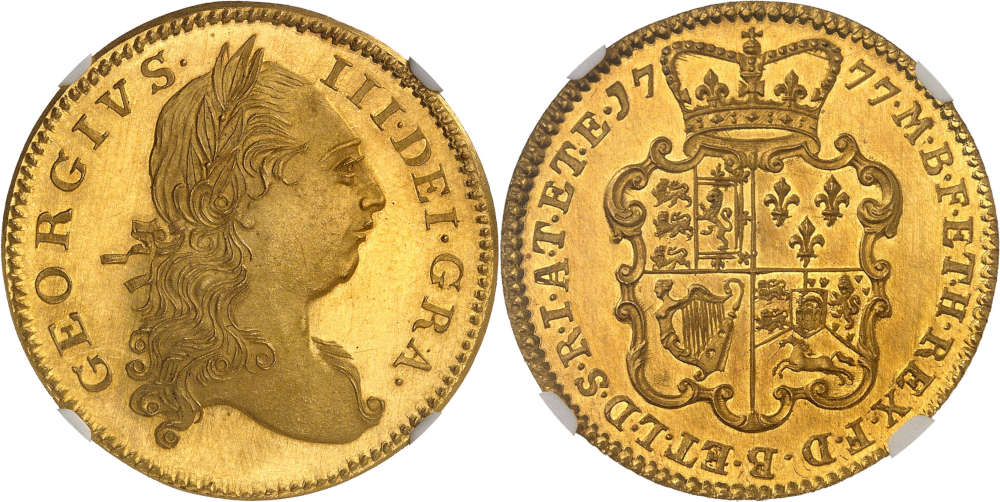
No. 123: Great Britain. George III, 1760-1820. Pattern of 2 guineas 1777, London. From the J. Halliburton Young Collection, Sotheby, Wilkinson & Hodge auction (1881), lot No. 446. Extremely rare. NGC PF63 CAMEO. Proof, minimally touched. Estimate: 100,000 euros. Hammer price: 130,000 euros.
3rd Place
Great Britain and China are another current trend, which is why these countries also dominate Künker’s top ten list. In third place – as mentioned above, with a hammer price of 130,000 euros against an estimate of 100,000 euros – we have an extremely rare patter for the 2-guineas coin minted in 1777 under George III.
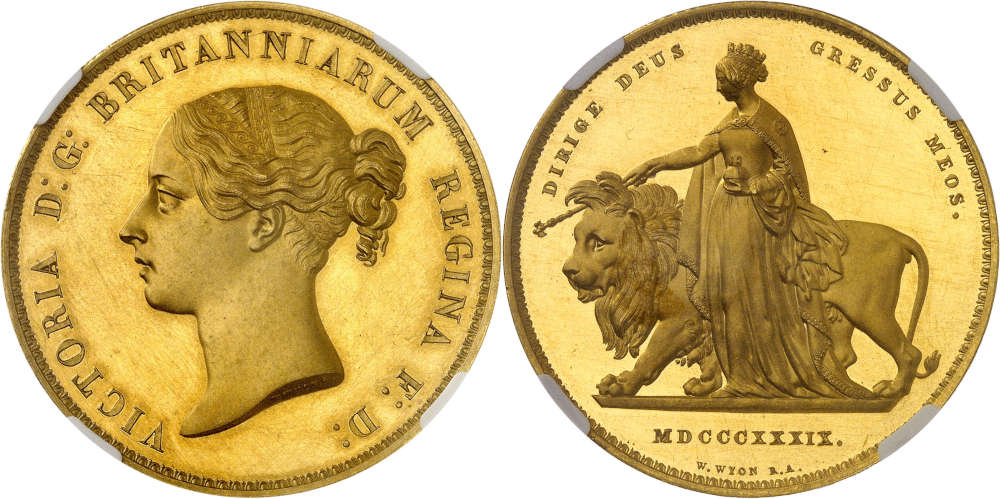
No. 127: Great Britain. Victoria, 1837-1901. 5 pounds 1839, London, “Una and the Lion“. Very rare. NGC PF61 CAMEO. Proof, minimally touched. Estimate: 100,000 euros. Hammer price: 190,000 euros.
2nd Place
Much more expensive was another pattern from Great Britain, created in 1839 with a mintage figure of 400 specimens. “Una and the Lion” is considered one of the most beautiful coins in numismatics and has repeatedly realized top results in recent years. In Künker’s Summer Auction Sales, a “Una” graded PF61 CAMEO by NGC and estimated at 100,000 euros was sold for 190,000 euros.
The history of this coin has also been told many times: William Wyon, the ingenious descendant of a dynasty of engravers, created this coin as an iconic issue with many allusions. “Una” originated in an epic poem that was dedicated to another great ruler, Elizabeth I. In this poem, the artist Edmund Spenser described all royal virtues as independent personalities. Una represented the faith in the true Church. This faith gave her so much power that she could even tame lions – and the English coat of arms consisted of three lions, which is why observers immediately associated the mighty animal with the nation.
The reality was quite different. Victoria made a lot of political mistakes in the first years of her reign. But no one thinks of that today when they look at the charming portrait of the youthful woman on the coin’s obverse.
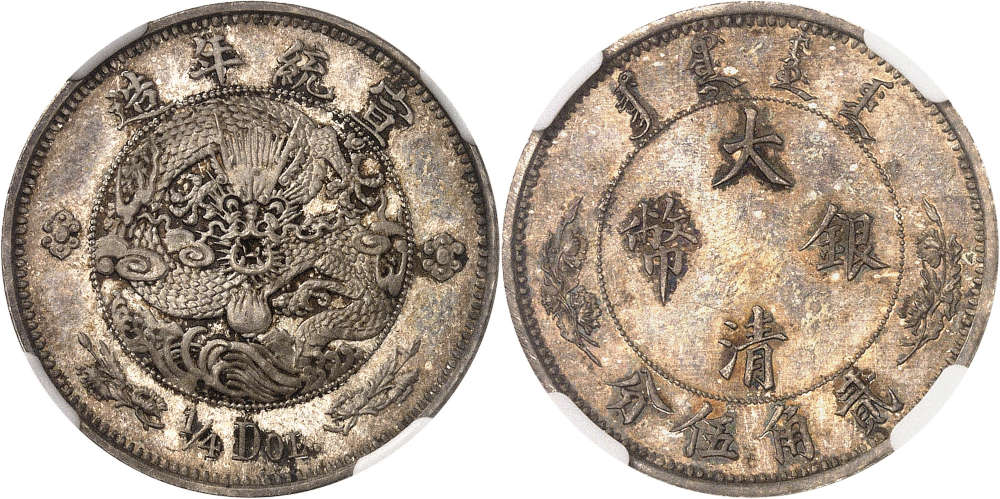
No. 754: China. Xuantong, 1908-1911. 10 cents (1/4 dollar) n.d. (1910), Tientsin. Pattern with smooth edge. NGC PF 65 CAMEO. Extremely rare. Proof. Estimate: 75,000 euros. Hammer price: 190,000 euros.
1st Place
And this brings us to the first place of our top ten list. 190,000 euros – just as much as “Una and the Lion” – was realized by another Chinese pattern from Tientsin, this time a 25-cent version. This is remarkable. After all, it is one of a few coins in our top ten list that is not made of gold but of silver. And yet, it achieved such a high price against an estimate of 75,000 euros. Its historical background is the same as that of the coin presented in 9th place. Both results demonstrate how strong the Chinese market still is.
It is remarkable that a Chinese pattern – even if it is of excellent quality – is sold for almost twice the price of the rarest gold and silver coins of the German Empire.
Although we only represented high-priced coins in this auction review, there were many pieces in both sales that any collector could have afforded. See for yourself and check out the results in detail.







